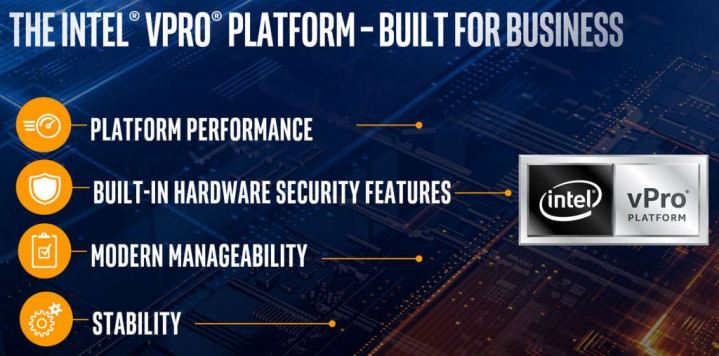The Comet Lake architecture from Intel received vPro processors. A total of 20 processors on the mobile and desktop will provide enterprise-wide security and management solutions.
After AMD updated the Ryzen 4000 APU series with Pro versions, Intel’s traditional vPro processors were released on schedule. Tenth-generation desktop and mobile vPro processors from the Comet Lake family are now official.
What does Comet Lake vPro offer?
Intel’s vPro processor series is different from standard processors in terms of management and security. Intel Hardware Shield technology, which provides hardware-level security solutions, and Intel Endpoint Management Assistant, which manages networked devices, are two examples.
In total, there are 11 processors on the desktop. The Core i9 series has 10 cores and 20 threads units. TDP values change as 35W, 65W, 125W. The Core i7 series consists of 3 processors, but the number of cores is 8. The Core i5 series has 5 processors with 6 cores.
It seems that Intel does not offer a vPro version under Core i5 in this generation. It is also stated that some processors can be overclocked. It is also stated that for the first time Intel is compatible with all 400 series chipsets instead of the Q series chipsets and therefore wants to offer vPro processors to a more widespread audience.
The 10th generation Intel Core vPro and 10th generation Intel Xeon W have a lineup of U and H processors for mobile and S processors for desktop. The specifications are as follows.
U processors:
| Base frequency | Maximum frequency | Number of cores | Number of threads | cache | TDP (Thermal design power) | |
| Core i5-10310U | 1.8GHz | 4.4GHz | Four | 8 | 6MB | 15W |
| Core i5-10610U | 1.7GHz | 4.9GHz | Four | 8 | 8MB | 15W |
| Core i7-10810U | 1.1GHz | 4.9GHz | 6 | 12 | 12 MB | 15W |
H processors:
| Base frequency | Maximum frequency | Number of cores | Number of threads | cache | TDP (Thermal design power) | |
| Core i5-10400H | 2.6GHz | 4.6GHz | Four | 8 | 8MB | 45W |
| Core i7-10850H | 2.7 GHz | 5.1GHz | 6 | 12 | 16MB | 45W |
| Core i7-10875H | 2.3GHz | 5.1GHz | 8 | 16 | 12 MB | 45W |
| Core i9-10400H | 2.4GHz | 5.1GHz | 8 | 16 | 16MB | 45W |
| Xeon W-10855M | 2.8GHz | 5.1GHz | 6 | 12 | 12 MB | 45W |
| Xeon W-10885M | 2.4GHz | 5.3GHz | 8 | 16 | 16MB | 45W |
S processors:
| Base frequency | Maximum frequency | Number of cores | Number of threads | cache | TDP (Thermal design power) | |
| Core i5-10500 | 3.1GHz | 4.5GHz | 6 | 12 | 12 MB | 65W |
| Core i5-10500T | 2.3GHz | 3.8GHz | 6 | 12 | 12 MB | 35W |
| Core i5-10600 | 3.3GHz | 4.8GHz | 6 | 12 | 12 MB | 65W |
| Core i5-10600T | 2.4GHz | 4.0GHz | 6 | 12 | 12 MB | 35W |
| Core i5-10600K | 4.1GHz | 4.8GHz | 6 | 12 | 12 MB | 125W |
| Core i7-10700 | 2.9GHz | 4.8GHz | 8 | 16 | 16MB | 65W |
| Core i7-10700T | 2.0GHz | 4.5GHz | 8 | 16 | 16MB | 35W |
| Core i7-10700K | 3.8GHz | 5.1GHz | 8 | 16 | 16MB | 125W |
| Core i9-10900 | 2.8GHz | 5.2GHz | Ten | 20 | 20 MB | 65W |
| Core i9-10900T | 1.9GHz | 4.6GHz | Ten | 20 | 20 MB | 35W |
| Core i9-10900K | 3.7GHz | 5.3GHz | Ten | 20 | 20 MB | 125W |
| Xeon W-1250 | 3.3GHz | 4.7GHz | 6 | 12 | 12 MB | 80W |
| Xeon W-1250P | 4.1GHz | 4.8GHz | 6 | 12 | 12 MB | 125W |
| Xeon W-1270 | 3.4GHz | 5.0 GHz | 8 | 16 | 16MB | 80W |
| Xeon W-1270P | 3.8GHz | 5.1GHz | 8 | 16 | 16MB | 125W |
| Xeon W-1290 | 3.2GHz | 5.2GHz | Ten | 20 | 20 MB | 80W |
| Xeon W-1290T | 1.9GHz | 4.7GHz | Ten | 20 | 20 MB | 35W |
| Xeon W-1290P | 3.7GHz | 5.3GHz | Ten | 20 | 20 MB | 125W |
